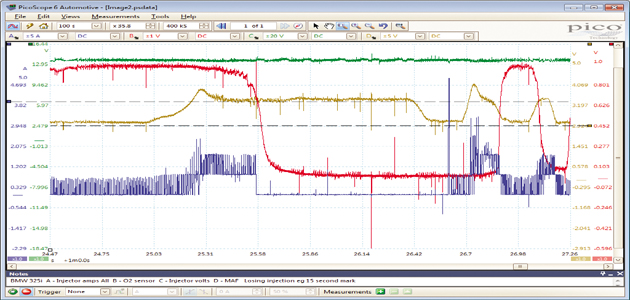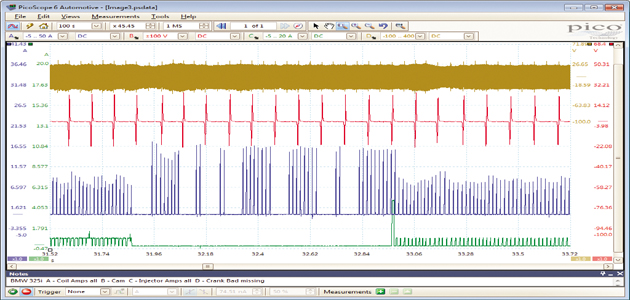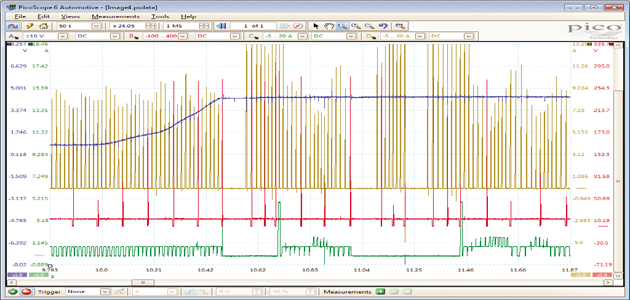
Technician: Andrew Clarke – Smart Tech Diagnostics, Western Sydney
Vehicle Details: BMW 6-Cylinder 325i E36
Year: 1991
Symptom: Lack of power, hesitation and occasional cutting out
I was presented with a 1991 6cyl E36325i BMW that had been suffering from an ongoing problem for the last two years that seemed repairable. The complaint from the customer was a lack of power, hesitation and the occasional cutting out on acceleration once warm.
First up was the test drive to confirm the fault. Sure enough, once warm, as I accelerated it bucked badly: a massive flat spot that was hard to drive through. This was also accompanied by what sounded like a lean backfire. To me, it appeared a definite lean fuel issue and, having six individual coils, the ignition system seemed an unlikely candidate.
Could this be easy pickings? A faulty MAF sensor was my first thought, but how could it be missed by so many? A quick scan revealed no codes to be logged so it was time to get the PicoScope out. My first choice to scope – and the easiest to access – was the MAF, TPS and O2 sensors.
This would help prove or disprove the MAF sensor to be at fault – the results were not as expected. The MAF voltage didn’t appear to be unusually low, but it was definitely going lean on acceleration. I also noted that at other times it appeared to stay in closed loop during WOT (Fig 1 below).

Fig 1
Now it was time to check fuel delivery. A quick volume and pressure test again gave no cause for concern. My next thought was to then do the same scope test, but this time access the injector loom, so I could observe the pulse width to confirm whether the ECU was trying to add fuel or not.
Making progress
Bingo! Now I knew why I had a lean miss and flat spot. The injection was being cut….totally. A quick set up change proved it was not losing its power supply to the injectors (Fig 2 below). I next decided to check what was happening to the ignition.

Fig 2
That also had problems; it was either totally missing or very erratic, along with some double stacking on the coils. This had to be some poor output from a crank or cam sensor? Nope, perfect (Fig 3 below). Perhaps the ECU then? I pulled out the ECU and checked the board. It did have evidence of water damage, but it was very minimal.

Fig 3
Could this be the cause of all these symptoms? It was at this point the customer called to get the verdict. I told him what I had found and at that particular moment my thoughts were that the ECU was causing the issue; however, I wanted a bit more time to think about all the evidence.
He then told me that BMW had also noticed the water damage and wanted to replace the ECU for a four figure sum, but there would be no guarantee of a fix. An expensive injector clean had already been carried out, and a new replacement MAF sensor had also been tried.
All resulted in no improvement. I then went back over my captures to look for some sort of a clue. Occasionally, the poor ignition control seemed to have an odd regularity to it. I decided to check which coils was actually a part of this irregular regularity. Out of the front three coils, cylinder ‘one’ followed by ‘two’ always fired.
Along with another two coils from the rear, this was the area of coil stacking – a clue perhaps? Number two, along with one of the rear coils, seemed to fire last in this regular area of poor ignition control. So, this time I connected up to the primary of number two to see if it revealed anything else (Fig 4 below).

Fig 4
Immediately, I could see a problem. When the ECU shut down injection and ignition, it was always preceding number two coil firing – jackpot! I also proved this further by disconnecting number two coil. The vehicle now ran as expected, apart from the single cylinder misfire. The coil was replaced and the fault fixed.
Conclusion
Although only a coil was the fix, it certainly did not behave as a simple bad coil problem would. Six other workshops had a crack at this job, and the car owner had been charged a princely sum for no eventual fix. Needless to say we had a very happy customer on our hands when the car was handed back over.









